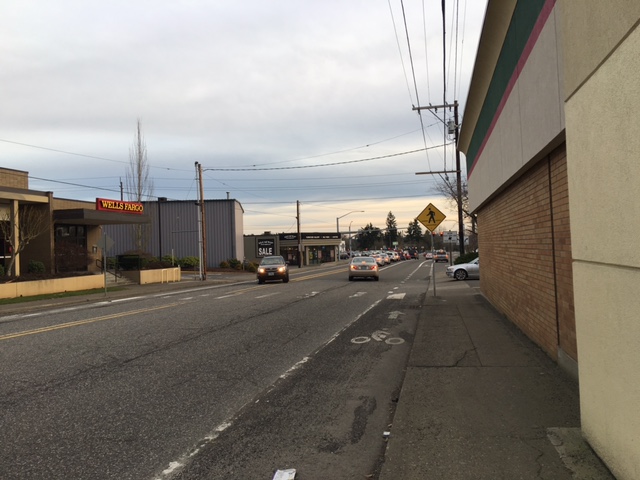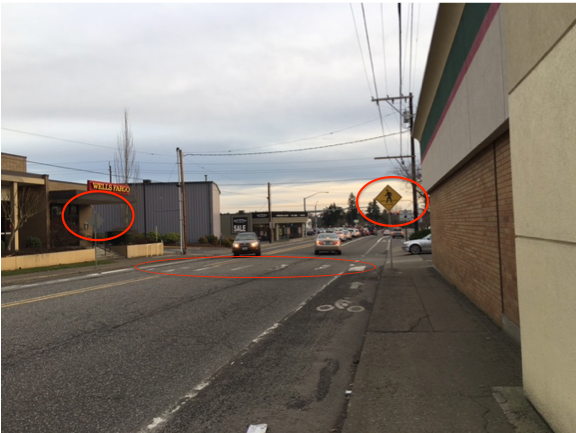Pedestrian Accident Lawsuit Filed by Mayor Law Seeking $7M in Damages
A pedestrian accident lawsuit has been filed by the law firm, Mayor Law, on behalf of a pedestrian accident victim struck by a pickup truck while crossing SW Hall Blvd in an uncontrolled, mid-block crosswalk. (Details of the accident and lawsuit covered by Oregonlive and The Times news sites) The lawsuit names the City of Tigard and the State of Oregon in 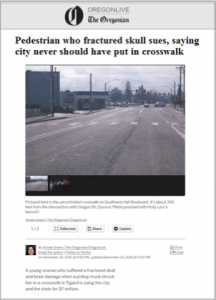
In December 2014, the victim, 19-year old Holly Lour, was crossing SW Hall Boulevard within the uncontrolled crosswalk. Both lanes of traffic stopped for her to cross, but after crossing the first lane she was struck by a pickup truck attempting to enter the left turn lane for traffic turning left on 99W. She suffered extensive injuries including a fractured pelvis, skull fracture, broken ribs, a collapsed lung, and worst of all a traumatic brain injury or TBI. Two years after the accident, Holly has undergone five major surgeries, but still suffers from cognitive damage to her brain. A condition that will most likely affect her for the rest of her life.
The complaint filed also alleges that the crosswalk she was using was known to be dangerous and on, “ODOT’s radar.” In 2012, pedestrian Greta Helmer, 79, was also struck while crossing the very same crosswalk.
What is an “uncontrolled” crosswalk?
This would be a good time to clarify a few terms that are frequently interchanged and oftentimes confused. Most everyone knows what a “crosswalk” is — a portion of the roadway at an intersection or elsewhere that is distinctly indicated for pedestrian crossing by painted lines or other markings on the surface.
We are very familiar with crosswalks in “controlled” locations – i.e. sites controlled by a traffic signal or a stop sign. Drivers are used to slowing down and stopping in these in areas, and are often able to anticipate there may be pedestrians present.
There are also crosswalks used at “uncontrolled” locations – i.e. sites NOT controlled by traffic signals or stop signs and sometimes at mid-block locations. A mid-block location is somewhere between intersections. There is a lot of controversy and conflicting studies regarding the safety effects of marked crosswalks at uncontrolled locations.
Under Oregon laws, a driver has specific duties to a pedestrian in a crosswalk, whether marked or unmarked. Drivers must stop and remain stopped for pedestrians until they have cleared the lane in which you are traveling (or into which you are turning) and must remain stopped.
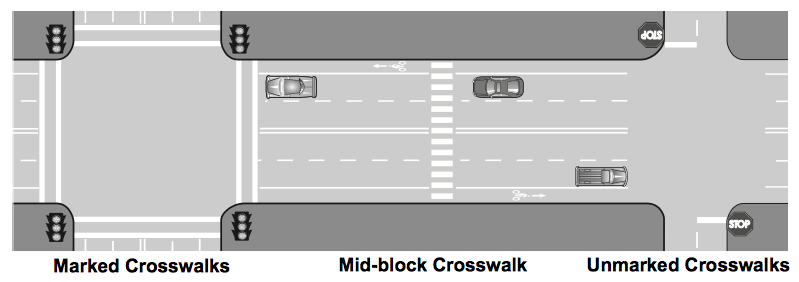
Portlandoregon.gov
Not All Crosswalks Are Created Equal
Recent crash data indicates Oregon has experienced a 28% increase in fatal accidents and an 18% increase in non-fatal accidents from 2014 to 2015, according to ODOT[1]. In 2015 there were 905 pedestrian accidents, of which 73 pedestrians were killed and 874 were injured. Most of these accidents were the result of drivers failing to yield the right-of-way to pedestrians crossing intersections and streets. The number one error amongst the pedestrians who were injured or killed was failing to use designated crosswalks, instead crossing the roadway somewhere between marked intersections.
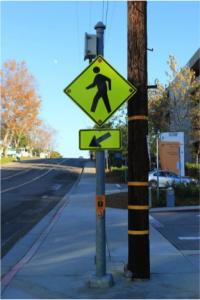
Yet, what happens when engineers determine that there are enough pedestrians to justify a marked mid-block crossing, yet it is not effectively analyzed or implemented? Poorly placed and designed crosswalks increase pedestrian-vehicle collision risks. They provide people with a false sense of safety.
Mid-block locations account for more than 70 percent of pedestrian fatalities.
“Mid-block locations account for more than 70 percent of pedestrian fatalities. In these areas, vehicle travel speeds tend to be higher, contributing to larger injury and fatality rates. More than 80 percent of pedestrians die when hit by vehicles traveling at 40 mph or faster, and less than 10 percent die when hit at 20 mph or less,” According to the U.S. Federal Highway Administration[2]
Even when well-marked and lit, mid-block crosswalks are more dangerous that crosswalks found at controlled intersections with traffic signals. The problem is, many drivers aren’t expecting a crosswalk, down see them, and don’t slow down.
Proper Pedestrian Safety Checks
Prior to implementing mid-block crosswalks, a proper safety engineering study should be completed. This safety engineering study will determine if the proposed mid-block crosswalk location is warranted, and what safety “crossing elements” are required to produce a safe and effective result. The study analyzes various aspects of the proposed crossing location including traffic volumes, vehicle speeds, road width, motorist compliance, pedestrian volumes, drivers ability to see the crosswalk, and historical accident data. These factors help determine what safety crossing elements must be incorporated into the crosswalk design and implementation.
Implementing a marked crosswalk without incorporating proper safety elements can result in an accident rate that is 5X higher than if the crosswalk didn’t exist.
In some instances, simply marking a crosswalk without incorporating additional safety elements or treatments can result in an accident rate that is 5-times higher than if the crosswalk was UNMARKED! That means the crosswalk could be more dangerous than if it never existed at all!
Dependent on many factors, some areas require advanced safety measures including, extra signage to alert drivers of an approaching crosswalk, an advance stop line, median refuge island, rapid flash beacons (RFBs), and high-visibility marking lines. For example, in Portland rapid flash beacons have been used to increase driver awareness and compliance of pedestrians attempting to cross busy streets, especially at night.
Mid-block Crosswalk Examples
Let’s look at some real examples. Would you recognize this as a midblock crosswalk while traveling at 30 mph?
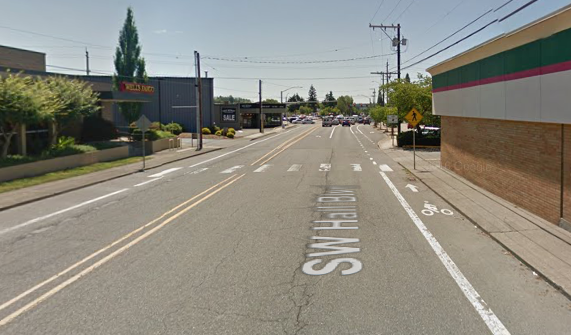
Map data ©2014 Google
How about the same crosswalk at dusk?
Now with safety devices outlined – marked crosswalk and crosswalk signs.
Here is an example of a pedestrian mid-block crosswalk, improved by the City of Portland since 2011. This picture does not show that the crosswalk signs also flash when a pedestrian is crossing.
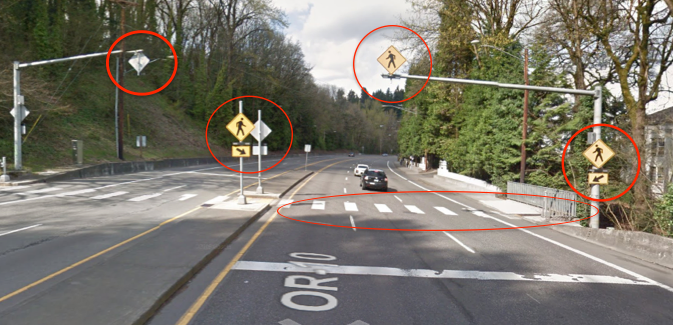
Map data ©2014 Google – Barbur Blvd
Q&A About Pedestrian Accidents and Mid-Block Crosswalks
Where do most pedestrian accidents occur?
According to the U.S. Department of Transportation, and confirmed by Oregon pedestrian accident data, most pedestrian accidents occur within crosswalks, and 50-70% of fatalities occur at mid-block locations[1]. These accidents are generally the fault of drivers failing to yield to pedestrians. Mid-block crossings are especially dangerous because drivers are not anticipating uncontrolled, mid-block crosswalks in dimly lit locations and where there is no intersection.
If mid-block crosswalks are where most fatal pedestrian accidents occur, then why install a mid-block crosswalk?
Mid-block crosswalks should be provided in areas that have high incidences of pedestrian crossings when intersections are too far away to be effective. Not every road or street needs a mid-block crosswalk, in a similar way not every intersection needs a stop sign or traffic light. But, when mid-block crosswalks are used, an engineering safety study must be completed to assess the needs, solution, and what safety elements must be incorporated into the implementation, to make it safe for both drivers and pedestrians. Studies have shown that implementing additional safety elements like rapid flashing beacons, pedestrian activated lights, and especially raised medians or pedestrian refuge areas at marked crosswalks are very effective ways of alerting drivers that pedestrians are about to cross the roadway. Evaluating the need for these safety elements are a fundamental part of the safety engineering study needed for all mid-block crosswalks. These additional safety elements have been shown to improve driver awareness of pedestrians and reduce pedestrian crashes by 46%[2].
What is the process for determining where a crosswalk should be placed?
In Oregon, state law (Oregon Revised Statute 801.220) mandates where crosswalks exist, what they look like, and how they are used. The law also provides local municipalities with the ability to place additional crosswalks at mid-block locations when the need is justified to improve public safety. The process involves completing a safety engineering study and seeking approval from the State Traffic Engineer. This is a formal process where a written request to review and approve the crosswalk need, design, and implementation is submitted to the ODOT Region Traffic Manager[3]. Because the State of Oregon regulates all laws and regulations associated with use of their roadways there must be consistent standards and design requirements across all of Oregon roadways. Hence the need for state regulation and approvals.
Do marked crosswalks provide a safe crossing mechanism?
Not always. In fact, a U.S. Department of Transportation study revealed, “… on multilane roads with traffic volumes above about 12,000 vehicles per day, having a marked crosswalk alone (without other substantial safety improvements) was associated with a higher pedestrian crash rate compared to an unmarked crosswalk.” In layman terms, simply installing a mid-block crosswalk designated with white painted lines yields a higher incidence of pedestrian-involved accidents – almost 4-5 times higher!
The Oregon Department of Transportation has published a brochure summarizing “What you need to know about Oregon Crosswalk Laws” that provides you with a basic understanding of who has the right-of-way on Oregon roadways. In another article written by Tigard’s Presiding Municipal Court Judge Michael J. O’Brien, Judge O’Brien states, “Oregon law requires drivers to stop whenever a pedestrian is in a marked or unmarked crosswalk. Every intersection has a crosswalk, with or without painted marks on the street. On roads with two or more lanes in each direction, it is unlawful to pass another vehicle that is stopped for a pedestrian. At traffic lights, wait until a pedestrian has cleared your lane and at least six feet of the next lane before making a turn. At other intersections, remain stopped until the pedestrian has cleared both your lane and the lane next to it.”
What is Oregon law related to driving and right-of-way for pedestrians in crosswalks?
The Oregon Department of Transportation has published a brochure summarizing “What you need to know about Oregon Crosswalk Laws” that provides you with a basic understanding of who has the right-of-way on Oregon roadways. In another article written by Tigard’s Presiding Municipal Court Judge Michael J. O’Brien, Judge O’Brien states, “Oregon law requires drivers to stop whenever a pedestrian is in a marked or unmarked crosswalk. Every intersection has a crosswalk, with or without painted marks on the street. On roads with two or more lanes in each direction, it is unlawful to pass another vehicle that is stopped for a pedestrian. At traffic lights, wait until a pedestrian has cleared your lane and at least six feet of the next lane before making a turn. At other intersections, remain stopped until the pedestrian has cleared both your lane and the lane next to it.”
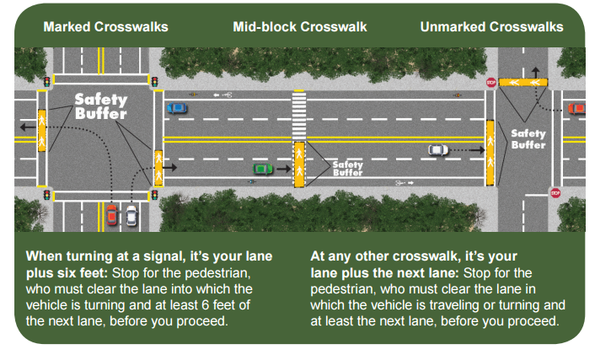
Portlandoregn.gov
If you have an unsafe crosswalk in your neighborhood what can you do about it?
Contact the Transportation or Traffic Engineering departments of your local municipality and let them know your concerns. For example, if you live in Portland you can contact the Portland Bureau of Transportation. If you live in Tigard, you can contact Traffic Engineering. These city departments are constantly evaluating the safety of their roadways and if you have information that will help in their evaluations you need to speak up.
Contact An Accident Attorney

If anyone in your family has been injured as a pedestrian, then you need to seek the help of a knowledgeable personal injury attorney. I am happy to discuss the details of your situation for FREE. Please call me call me at (503) 610-0005 or (800) 949-1481, or email me at travis@mayorlaw.com, to learn more about your legal rights.
More Mayor Law Articles
Pedestrian Accident Victim – Reduce Your Risk
7 Pedestrian Safety Tips I Will Teach My Children
Free Legal Consultation with a Personal Injury Lawyer
[1] Source: http://safety.fhwa.dot.gov/provencountermeasures/fhwa_sa_12_011.cfm.
[2] Source: http://safety.fhwa.dot.gov/provencountermeasures/fhwa_sa_12_011.cfm.
[3] Source: https://www.oregon.gov/ODOT/HWY/TRAFFIC-ROADWAY/docs/pdf/crosswalk_brochure.pdf.
[1] Source: https://www.oregon.gov/ODOT/TD/TDATA/car/docs/2015_QuickFacts.pdf.
[2] Source: http://safety.fhwa.dot.gov/provencountermeasures/fhwa_sa_12_011.cfm.

